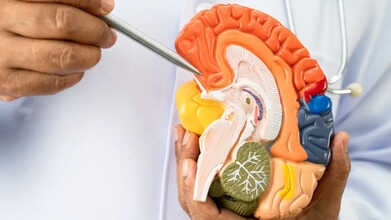- Health Conditions A-Z
- Health & Wellness
- Nutrition
- Fitness
- Health News
- Ayurveda
- Videos
- Medicine A-Z
- Parenting
- Web Stories
What Happens To Women's Body When There is Iron Deficiency

What Happens To Women's Body When There is Iron Deficiency (Credit: Canva)
Iron deficiency is a pervasive health concern, particularly affecting women of reproductive age. This condition can lead to various complications, including fatigue, anemia, and adverse outcomes during pregnancy. Women are particularly susceptible due to factors like menstruation, pregnancy, and dietary choices. Understanding the causes, symptoms, and methods of prevention is essential for maintaining optimal health.
A study published in the PubMed, titled 'Iron deficiency in women: assessment, causes and consequences' stated that iron deficiency is the most prevalent nutritional disorder worldwide, impacting approximately 20-25% of the global population, with children and women being the most affected.
Recent research indicates that the depletion of iron reserves can lead to negative health effects in adults, even without the presence of anaemia. This underscores the need to reevaluate and refine the methods used to assess iron levels effectively.
Why Do So Many Women Lack Iron?
Iron is crucial for the body to function properly. It is a key component in the production of red blood cells, muscle tissues, enzymes, and other molecules. These elements are essential for maintaining energy levels, supporting the immune system, and carrying oxygen throughout the body. The body also loses iron through daily shedding of skin cells and, for women, particularly through menstruation.
Women who experience heavy menstrual cycles are at a higher risk of iron deficiency due to the significant blood loss they experience each month. A heavy period can be identified by certain symptoms, such as needing to change pads or tampons more than five to six times a day, bleeding for more than seven days, or passing blood clots larger than a quarter coin.
In addition to menstruation, the adolescent phase presents challenges in iron absorption. Young women often fail to meet their iron needs through diet, which is exacerbated if they do not consume enough iron-rich foods like red meat or green leafy vegetables. For women who are pregnant or breastfeeding, the demand for iron increases dramatically.
During pregnancy, iron is needed for both the mother and the developing baby, further increasing the risk of deficiency if dietary intake isn’t sufficient.
How Much Iron Do Women Need?
The daily recommended intake of iron varies depending on age, lifestyle, and reproductive status. Women between the ages of 19 and 50 typically require around 18 mg of iron per day. Pregnant women need even more, around 27 mg per day, due to the increased demand for blood production.
Women over 50 and postmenopausal women require less, approximately 8 mg daily, because they no longer experience monthly menstrual blood loss.
Common dietary sources of iron include lean red meat, eggs, leafy greens, legumes, beans, and iron-fortified cereals. However, it’s important to note that iron from plant-based foods is not as easily absorbed by the body as iron from animal sources. Women who follow a vegetarian or vegan diet may need to consume more iron-rich foods or take supplements to meet their body’s needs.
What Happens When You Don’t Have Enough Iron?
When the body doesn't receive sufficient iron, it starts to conserve iron and use it for only the most essential functions. This can lead to a condition called iron-deficiency anemia, where the body produces fewer red blood cells, and the hemoglobin levels decrease. Hemoglobin is essential for oxygen transport in the body, and when levels drop, the body struggles to deliver oxygen to tissues and organs.
Common symptoms of iron deficiency include:
- Fatigue
- Shortness of breath
- Pale skin
- Dizziness or headaches
- Brittle nails and hair loss
If iron deficiency progresses without intervention, it can lead to more severe conditions like chronic anemia. Iron deficiency without anemia is also a concern, as it can still negatively impact cognitive function, mood, and energy levels.
Iron Deficiency vs. Iron-Deficiency Anemia
It is important to differentiate between iron deficiency and iron-deficiency anemia. Iron deficiency occurs when the body’s iron stores are depleted, but the hemoglobin levels are still within a normal range.
This stage is often undiagnosed because the body may not yet exhibit symptoms. On the other hand, iron-deficiency anemia is the final stage of iron deficiency, where both iron stores and hemoglobin levels are critically low.
A common diagnostic method for assessing iron stores is a ferritin blood test, which measures the amount of stored iron. A ferritin level below 30 μg/L is generally considered indicative of iron deficiency.
Who is at Risk?
Certain groups are more susceptible to iron deficiency, particularly women who:
- Have heavy menstrual cycles
- Are pregnant or breastfeeding
- Have recently given birth
- Follow vegetarian or vegan diets
- Have undergone major surgeries or experienced physical trauma
- Suffer from gastrointestinal conditions such as Celiac disease or inflammatory bowel diseases
Additionally, women who have undergone bariatric surgeries, such as gastric bypass, are at an elevated risk because their ability to absorb nutrients, including iron, is compromised. Children who consume large amounts of cow's milk may also be at risk because cow’s milk contains little iron and can reduce its absorption while causing potential irritation to the intestinal lining.
Preventing and Treating Iron Deficiency
The most effective way to prevent iron deficiency is through diet. Consuming iron-rich foods like beef, liver, fish, dark green leafy vegetables, and legumes helps maintain healthy iron levels. It’s also essential to consume vitamin C-rich foods like citrus fruits, bell peppers, and tomatoes, as vitamin C enhances iron absorption.
For women who are at risk of iron deficiency, routine blood tests can help detect any imbalances early. Tests to measure hemoglobin levels and ferritin provide insight into both immediate and long-term iron stores. If iron deficiency is identified, treatment may involve dietary changes and supplements.
Iron supplements are available in oral or intravenous forms, and they can correct iron levels within three to four months of treatment. However, supplements should only be taken under the guidance of a healthcare professional, as excessive iron intake can cause other health problems.
Iron deficiency is a widespread but often overlooked health issue, particularly for women of reproductive age. Heavy menstrual cycles, pregnancy, and dietary choices contribute to iron loss, and if left untreated, iron deficiency can lead to severe complications like iron-deficiency anemia.
Prevention through a well-balanced diet rich in iron and early diagnosis via blood tests are critical for maintaining optimal health. For women experiencing symptoms of iron deficiency, consulting a healthcare provider for proper testing and treatment is essential to restore energy levels and overall well-being.
Alzheimer’s In Women: Why Women Are At Higher Risk And How To Detect It Early

Image credits: Canva
Did you know that among the 6.2 million Americans aged 65 and older living with Alzheimer’s disease, nearly two-thirds are women? This means women are almost twice as likely as men to develop the condition. While longer life expectancy partly explains the difference, research shows that hormonal changes after menopause, genetic factors, and certain lifestyle patterns also increase risk.
As a result, understanding the early warning signs and taking preventive steps is especially important for women, who face a higher likelihood of developing Alzheimer’s as they age.
Women and Alzheimer’s: Why The Risk Is Higher
Dr. Brij Lal Choudhary, Consultant Neurologist at Manipal Hospital, Jaipur, points out that Alzheimer’s is often seen as a condition of old age, but women are disproportionately affected. Nearly two-thirds of Alzheimer’s patients are women, making it almost twice as common in women compared to men. While longer life expectancy plays a role, other factors, such as hormonal changes after menopause, genetic predisposition, and lifestyle patterns also increase risk.
Early Signs of Alzheimer’s Women Should Watch
Recognising early symptoms is key, as catching them in time can make a significant difference. Common signs include:Memory loss: Forgetting recent events, appointments, or familiar names, with lapses gradually worsening.
ALSO READ: Chronic Insomnia Could Increase The Risk Of Dementia By 40%: Study
- Difficulty managing tasks or problem-solving: Struggling with daily responsibilities, finances, or planning may indicate cognitive changes.
- Confusion: Feeling disoriented over simple or familiar activities.
- Mood or personality changes: Sudden anxiety, frequent irritability, or withdrawing from social life.
- Language difficulties: Trouble finding the right words or expressing thoughts clearly.
Increased Risk of Alzheimer's in WomenStudies consistently show that women are at a higher risk of developing Alzheimer's disease compared to men. For instance, a Swedish study involving 16,926 participants found that, starting around age 80, women were more likely to be diagnosed with Alzheimer's than men of the same age. Similarly, research in Taiwan indicated that over a seven-year period, women had a higher likelihood of developing Alzheimer's compared to men. A European meta-analysis revealed that approximately 13 women out of 1,000 developed Alzheimer's each year, compared to only seven men, as per Harvard Health Publishing.
ALSO READ: CDC Vaccine Panel Updates COVID-19 Guidelines: What You Need To Know
While the longer life expectancy of women contributes to this disparity, it doesn't fully explain the difference. Even among individuals of the same age, women are more likely to be diagnosed with Alzheimer's than men. This suggests that factors beyond longevity, such as hormonal changes, genetic predispositions, and immune system differences, may play significant roles in the increased risk for women.
How to Reduce Risk and Protect Cognitive HealthAlthough Alzheimer’s cannot be reversed, several steps can help lower risk and support brain health:
- Regular cognitive screenings to monitor changes over time.
- Mental stimulation through reading, puzzles, or learning new skills.
- Physical exercise to improve blood flow and overall health.
- Managing blood pressure and blood sugar to reduce vascular-related risks.
World Alzheimer’s Day 2025: 5 Early Warning Signs of Alzheimer’s Experts Say You Must Know

Credits: Canva
We all experience occasional forgetfulness or feel a bit scatterbrained from time to time, often attributing it to stress, a busy lifestyle, or simply getting older. However, repeated lapses in memory, confusion, or difficulty performing everyday tasks can sometimes signal the early stages of Alzheimer’s or other forms of dementia. Recognising these warning signs early is crucial, as timely awareness and intervention can help manage the condition more effectively and improve quality of life.
As we observe World Alzheimer’s Day 2025, it’s the perfect moment to learn about Alzheimer’s, understand its early indicators, and know what experts recommend paying attention to.
What Is Alzheimer’s?
Alzheimer’s disease is the most common form of dementia, a progressive brain disorder that gradually declines memory, thinking, and reasoning skills. It affects cognitive functioning and daily behaviours to such an extent that simple tasks, like eating, dressing, or walking can become challenging over time.ALSO READ: Chronic Insomnia Could Increase The Risk Of Dementia By 40%: Study
For most people, symptoms first appear in their mid-60s, according to the National Institute on Aging. Current estimates indicate that over 6 million Americans aged 65 and older may be living with Alzheimer’s. Age remains the greatest known risk factor, and with the population aging, the number of cases is expected to rise.
Stages of Alzheimer’sAlzheimer’s disease progresses gradually, with symptoms worsening over time. It is generally divided into three stages: early (mild), middle (moderate), and late (severe). In the early stage, memory lapses and confusion begin to interfere with daily life. During the middle stage, challenges with language, reasoning, and daily activities become more pronounced. In the late stage, individuals may lose the ability to communicate, require full-time care, and become highly dependent on others. Understanding the stages helps families and caregivers plan support and interventions more effectively.
Alzheimer’s vs Dementia
While Alzheimer’s is the most common cause of dementia, the two terms are not interchangeable. Dementia is a broad term describing a decline in cognitive function severe enough to interfere with daily life. Alzheimer’s specifically refers to a progressive brain disease marked by amyloid plaques and tau tangles, leading to memory loss and impaired thinking. Other types of dementia include vascular dementia, Lewy body dementia, and frontotemporal dementia, each with distinct causes and symptoms. Knowing the difference is essential for accurate diagnosis and treatment planning.Early Warning Signs of Alzheimer’s
Recognising the early warning signs of Alzheimer’s can help with timely diagnosis and care. Dr. Prajwal Rao, DM Neurology, Professor and Head of the Department of Neurology at Dr. D. Y Patil Medical College, Hospital and Research Center, Pimpri, Pune, explains:- Persistent Memory Loss: Forgetting recent conversations, events, or important dates more often than usual, affecting daily life.
- Difficulty in Planning or Problem-Solving: Challenges with tasks like handling finances, following recipes, or keeping track of everyday responsibilities.
- Impairment of Spatial Memory: Forgetting familiar routes or even one’s way back home.
- Changes in Mood or Personality: Increased irritability, withdrawal from social activities, or unexpected anxiety and depression.
Severe Pregnancy Nausea Could Impact Mental Health, Research Shows

Credits: Canva
Morning sickness is often treated as just an unpleasant part of early pregnancy, but for some women, the nausea and vomiting can be severe and relentless. A recent study suggests that this extreme form of morning sickness, known as hyperemesis gravidarum, may also affect mental health. Women experiencing it are at a higher risk of anxiety, depression, and stress-related challenges, making it important to recognise the emotional impact alongside the physical symptoms.
Severe Morning Sickness and Mental Health: What the Study Found
A large study conducted by researchers from King’s College London and the South London and Maudsley NHS Foundation Trust examined the mental health impact of hyperemesis gravidarum (HG), a severe form of morning sickness. The study analyzed data from 476,857 pregnant women across 135 healthcare providers worldwide using the TriNetX Global Collaborative Network, which collects anonymized electronic health records from 18 countries. This research is the first to explore a broad range of neuropsychiatric outcomes in women with HG.
What Is Hyperemesis Gravidarum?
HG affects up to 3.6% of pregnancies and is the leading cause of hospitalization during the first trimester. Women with HG experience persistent, severe nausea and vomiting, often resulting in dehydration, weight loss, and malnutrition. The condition can cause anxiety, isolation, and uncertainty about coping with pregnancy. In severe cases, women have reported considering termination of pregnancy due to the physical and emotional toll.
Maternal risk factors include biological issues such as thyroid disorders, Type 1 diabetes, and past pregnancy complications, as well as socioeconomic and ethnic factors. Research also points to sensitivity to the hormone GDF-15 as a potential driver.
The Link Between Hyperemesis Gravidarum and Mental Health
The study looked at 24 neuropsychiatric and mental health outcomes within a year of HG diagnosis. Findings included:
- 50% increased risk in 13 conditions, including postpartum psychosis and PTSD.
- Doubled risk for Wernicke’s encephalopathy, refeeding syndrome, eating disorders, and depression.
- Postpartum depression was 2.7 times more likely among women with HG.
Why Integrated Care Matters
Dr. Thomas Pollak, consultant neuropsychiatrist and senior author, noted that there has historically been a disconnect between how doctors view HG and how women experience it. The study shows that HG can be linked to severe psychiatric disorders, which require early recognition and coordinated physical and mental healthcare from the start of pregnancy.
ALSO READ: US Health Officials To Examine Covid Vaccine Effects In Pregnant Women And Kids
This research highlights that mental health support is crucial, even if HG seems physically mild, and that women with HG should have access to integrated care to ensure their wellbeing and safety for both mother and child.
© 2024 Bennett, Coleman & Company Limited

